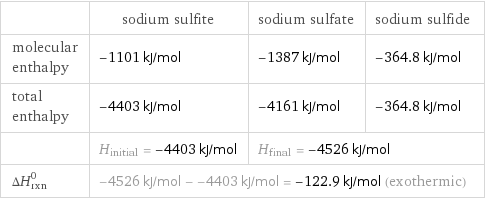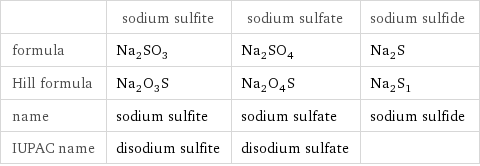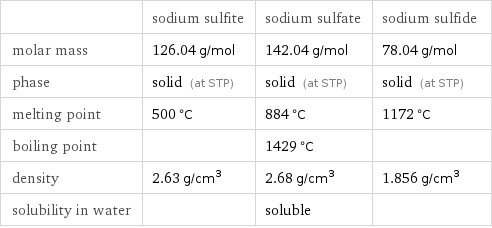Input interpretation

Na_2SO_3 (sodium sulfite) ⟶ Na_2SO_4 (sodium sulfate) + Na_2S (sodium sulfide)
Balanced equation

Balance the chemical equation algebraically: Na_2SO_3 ⟶ Na_2SO_4 + Na_2S Add stoichiometric coefficients, c_i, to the reactants and products: c_1 Na_2SO_3 ⟶ c_2 Na_2SO_4 + c_3 Na_2S Set the number of atoms in the reactants equal to the number of atoms in the products for Na, O and S: Na: | 2 c_1 = 2 c_2 + 2 c_3 O: | 3 c_1 = 4 c_2 S: | c_1 = c_2 + c_3 Since the coefficients are relative quantities and underdetermined, choose a coefficient to set arbitrarily. To keep the coefficients small, the arbitrary value is ordinarily one. For instance, set c_3 = 1 and solve the system of equations for the remaining coefficients: c_1 = 4 c_2 = 3 c_3 = 1 Substitute the coefficients into the chemical reaction to obtain the balanced equation: Answer: | | 4 Na_2SO_3 ⟶ 3 Na_2SO_4 + Na_2S
Structures

⟶ +
Names

sodium sulfite ⟶ sodium sulfate + sodium sulfide
Reaction thermodynamics
Enthalpy

| sodium sulfite | sodium sulfate | sodium sulfide molecular enthalpy | -1101 kJ/mol | -1387 kJ/mol | -364.8 kJ/mol total enthalpy | -4403 kJ/mol | -4161 kJ/mol | -364.8 kJ/mol | H_initial = -4403 kJ/mol | H_final = -4526 kJ/mol | ΔH_rxn^0 | -4526 kJ/mol - -4403 kJ/mol = -122.9 kJ/mol (exothermic) | |
Gibbs free energy

| sodium sulfite | sodium sulfate | sodium sulfide molecular free energy | -10125 kJ/mol | -1270 kJ/mol | -349.8 kJ/mol total free energy | -40500 kJ/mol | -3811 kJ/mol | -349.8 kJ/mol | G_initial = -40500 kJ/mol | G_final = -4160 kJ/mol | ΔG_rxn^0 | -4160 kJ/mol - -40500 kJ/mol = 36340 kJ/mol (endergonic) | |
Equilibrium constant
![Construct the equilibrium constant, K, expression for: Na_2SO_3 ⟶ Na_2SO_4 + Na_2S Plan: • Balance the chemical equation. • Determine the stoichiometric numbers. • Assemble the activity expression for each chemical species. • Use the activity expressions to build the equilibrium constant expression. Write the balanced chemical equation: 4 Na_2SO_3 ⟶ 3 Na_2SO_4 + Na_2S Assign stoichiometric numbers, ν_i, using the stoichiometric coefficients, c_i, from the balanced chemical equation in the following manner: ν_i = -c_i for reactants and ν_i = c_i for products: chemical species | c_i | ν_i Na_2SO_3 | 4 | -4 Na_2SO_4 | 3 | 3 Na_2S | 1 | 1 Assemble the activity expressions accounting for the state of matter and ν_i: chemical species | c_i | ν_i | activity expression Na_2SO_3 | 4 | -4 | ([Na2SO3])^(-4) Na_2SO_4 | 3 | 3 | ([Na2SO4])^3 Na_2S | 1 | 1 | [Na2S] The equilibrium constant symbol in the concentration basis is: K_c Mulitply the activity expressions to arrive at the K_c expression: Answer: | | K_c = ([Na2SO3])^(-4) ([Na2SO4])^3 [Na2S] = (([Na2SO4])^3 [Na2S])/([Na2SO3])^4](../image_source/c2d469a16401cd338e32a9e17d9b5996.png)
Construct the equilibrium constant, K, expression for: Na_2SO_3 ⟶ Na_2SO_4 + Na_2S Plan: • Balance the chemical equation. • Determine the stoichiometric numbers. • Assemble the activity expression for each chemical species. • Use the activity expressions to build the equilibrium constant expression. Write the balanced chemical equation: 4 Na_2SO_3 ⟶ 3 Na_2SO_4 + Na_2S Assign stoichiometric numbers, ν_i, using the stoichiometric coefficients, c_i, from the balanced chemical equation in the following manner: ν_i = -c_i for reactants and ν_i = c_i for products: chemical species | c_i | ν_i Na_2SO_3 | 4 | -4 Na_2SO_4 | 3 | 3 Na_2S | 1 | 1 Assemble the activity expressions accounting for the state of matter and ν_i: chemical species | c_i | ν_i | activity expression Na_2SO_3 | 4 | -4 | ([Na2SO3])^(-4) Na_2SO_4 | 3 | 3 | ([Na2SO4])^3 Na_2S | 1 | 1 | [Na2S] The equilibrium constant symbol in the concentration basis is: K_c Mulitply the activity expressions to arrive at the K_c expression: Answer: | | K_c = ([Na2SO3])^(-4) ([Na2SO4])^3 [Na2S] = (([Na2SO4])^3 [Na2S])/([Na2SO3])^4
Rate of reaction
![Construct the rate of reaction expression for: Na_2SO_3 ⟶ Na_2SO_4 + Na_2S Plan: • Balance the chemical equation. • Determine the stoichiometric numbers. • Assemble the rate term for each chemical species. • Write the rate of reaction expression. Write the balanced chemical equation: 4 Na_2SO_3 ⟶ 3 Na_2SO_4 + Na_2S Assign stoichiometric numbers, ν_i, using the stoichiometric coefficients, c_i, from the balanced chemical equation in the following manner: ν_i = -c_i for reactants and ν_i = c_i for products: chemical species | c_i | ν_i Na_2SO_3 | 4 | -4 Na_2SO_4 | 3 | 3 Na_2S | 1 | 1 The rate term for each chemical species, B_i, is 1/ν_i(Δ[B_i])/(Δt) where [B_i] is the amount concentration and t is time: chemical species | c_i | ν_i | rate term Na_2SO_3 | 4 | -4 | -1/4 (Δ[Na2SO3])/(Δt) Na_2SO_4 | 3 | 3 | 1/3 (Δ[Na2SO4])/(Δt) Na_2S | 1 | 1 | (Δ[Na2S])/(Δt) (for infinitesimal rate of change, replace Δ with d) Set the rate terms equal to each other to arrive at the rate expression: Answer: | | rate = -1/4 (Δ[Na2SO3])/(Δt) = 1/3 (Δ[Na2SO4])/(Δt) = (Δ[Na2S])/(Δt) (assuming constant volume and no accumulation of intermediates or side products)](../image_source/70f443c19c4940f05b42557d51b688cc.png)
Construct the rate of reaction expression for: Na_2SO_3 ⟶ Na_2SO_4 + Na_2S Plan: • Balance the chemical equation. • Determine the stoichiometric numbers. • Assemble the rate term for each chemical species. • Write the rate of reaction expression. Write the balanced chemical equation: 4 Na_2SO_3 ⟶ 3 Na_2SO_4 + Na_2S Assign stoichiometric numbers, ν_i, using the stoichiometric coefficients, c_i, from the balanced chemical equation in the following manner: ν_i = -c_i for reactants and ν_i = c_i for products: chemical species | c_i | ν_i Na_2SO_3 | 4 | -4 Na_2SO_4 | 3 | 3 Na_2S | 1 | 1 The rate term for each chemical species, B_i, is 1/ν_i(Δ[B_i])/(Δt) where [B_i] is the amount concentration and t is time: chemical species | c_i | ν_i | rate term Na_2SO_3 | 4 | -4 | -1/4 (Δ[Na2SO3])/(Δt) Na_2SO_4 | 3 | 3 | 1/3 (Δ[Na2SO4])/(Δt) Na_2S | 1 | 1 | (Δ[Na2S])/(Δt) (for infinitesimal rate of change, replace Δ with d) Set the rate terms equal to each other to arrive at the rate expression: Answer: | | rate = -1/4 (Δ[Na2SO3])/(Δt) = 1/3 (Δ[Na2SO4])/(Δt) = (Δ[Na2S])/(Δt) (assuming constant volume and no accumulation of intermediates or side products)
Chemical names and formulas

| sodium sulfite | sodium sulfate | sodium sulfide formula | Na_2SO_3 | Na_2SO_4 | Na_2S Hill formula | Na_2O_3S | Na_2O_4S | Na_2S_1 name | sodium sulfite | sodium sulfate | sodium sulfide IUPAC name | disodium sulfite | disodium sulfate |
Substance properties

| sodium sulfite | sodium sulfate | sodium sulfide molar mass | 126.04 g/mol | 142.04 g/mol | 78.04 g/mol phase | solid (at STP) | solid (at STP) | solid (at STP) melting point | 500 °C | 884 °C | 1172 °C boiling point | | 1429 °C | density | 2.63 g/cm^3 | 2.68 g/cm^3 | 1.856 g/cm^3 solubility in water | | soluble |
Units
